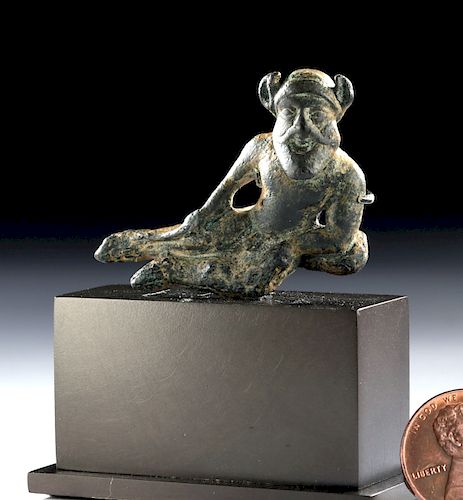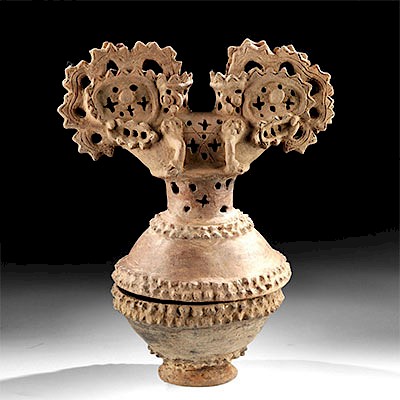Rare Miniature Etruscan Bronze Reclining Satyr Applique
Lot 20
About Seller
Artemis Gallery
686 S Taylor Ave, Ste 106
Louisville, CO 80027
United States
Selling antiquities, ancient and ethnographic art online since 1993, Artemis Gallery specializes in Classical Antiquities (Egyptian, Greek, Roman, Near Eastern), Asian, Pre-Columbian, African / Tribal / Oceanographic art. Our extensive inventory includes pottery, stone, metal, wood, glass and textil...Read more
Categories
Estimate:
$2,500 - $3,500
Absentee vs Live bid
Two ways to bid:
- Leave a max absentee bid and the platform will bid on your behalf up to your maximum bid during the live auction.
- Bid live during the auction and your bids will be submitted real-time to the auctioneer.
Bid Increments
| Price | Bid Increment |
|---|---|
| $0 | $25 |
| $300 | $50 |
| $1,000 | $100 |
| $2,000 | $250 |
| $5,000 | $500 |
| $10,000 | $1,000 |
| $20,000 | $2,500 |
| $50,000 | $5,000 |
| $100,000 | $10,000 |
| $200,000 | $20,000 |
About Auction
By Artemis Gallery
Aug 22, 2019
Set Reminder
2019-08-22 10:00:00
2019-08-22 10:00:00
America/New_York
Bidsquare
Bidsquare : Fine Ancient | Asian | Ethnographic Art
https://www.bidsquare.com/auctions/artemis-gallery/fine-ancient-asian-ethnographic-art-4348
Featuring classical antiquities, ancient and ethnographic art from cultures encompassing the globe, plus fine art. Egyptian, Greek, Roman, Etruscan, Near Eastern, Asian, Pre-Columbian, Native American, African / Tribal, Oceanic, Spanish Colonial, Russian, Fine Art, so much more! Artemis Gallery info@artemisgallery.com
Featuring classical antiquities, ancient and ethnographic art from cultures encompassing the globe, plus fine art. Egyptian, Greek, Roman, Etruscan, Near Eastern, Asian, Pre-Columbian, Native American, African / Tribal, Oceanic, Spanish Colonial, Russian, Fine Art, so much more! Artemis Gallery info@artemisgallery.com
- Lot Description
Etruria, northern Italy, ca. 6th to 5th century BCE. A solid bronze statuette, finely cast via the lost wax (cire perdue) process, depicting a satyr - possibly Silenus - reclining on a lion's skin. The satyr's head is characteristically horned; his face presents a thick, bushy mustache and beard; his body presents cloven hooves further revealing his goat-like aspect. A wonderful depiction of a devotee to Dionysos, god of wine. Size: 1.75" W x 1.375" H (4.4 cm x 3.5 cm); 2.5" H (6.4 cm) on included custom stand.
Satyrs were powerful symbols in ancient Rome, associated with the joy of the Bacchanal. This example is likely Silenus, a satyr-like figure who was an older companion to Bacchus (Dionysus). The consumption of wine was an important social activity in Roman society and Silenus was commonly added to decorative items to signify the owner's affiliation with the cult of Bacchus. Themes of the god and his followers were particularly popular during the early part of this time period, as control of the Mediterranean shifted from Greece to Rome.
An Etruscan bronze applique of a reclining Satyr sold for $4,250 at Sotheby's London - 3 July 2018 - Lot 11 - http://www.sothebys.com/en/auctions/ecatalogue/2018/ancient-marbles-classical-sculpture-and-l18260/lot.11.html
See a similar example at the Metropolitan Museum of Art, this one reclining on a wineskin and playing Pan pipes (1972.118.65) - https://www.metmuseum.org/art/collection/search/255378
Provenance: private East Coast, USA collection; ex-Neil Phillips collection, New York, USA, acquired in the 1980s
All items legal to buy/sell under U.S. Statute covering cultural patrimony Code 2600, CHAPTER 14, and are guaranteed to be as described or your money back.
A Certificate of Authenticity will accompany all winning bids.
We ship worldwide and handle all shipping in-house for your convenience.
#146865Intact. Gorgeous deep green and russet patina.Condition
- Shipping Info
-
All shipping is handled in-house for your convenience. Your invoice from Artemis Gallery will include shipping calculation instructions. If in doubt, please inquire BEFORE bidding for estimated shipping costs for individual items.
-
- Buyer's Premium



 EUR
EUR CAD
CAD AUD
AUD GBP
GBP MXN
MXN HKD
HKD CNY
CNY MYR
MYR SEK
SEK SGD
SGD CHF
CHF THB
THB














